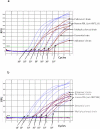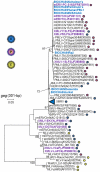Detection of murine leukemia virus or mouse DNA in commercial RT-PCR reagents and human DNAs
- PMID: 22205995
- PMCID: PMC3243700
- DOI: 10.1371/journal.pone.0029050
Detection of murine leukemia virus or mouse DNA in commercial RT-PCR reagents and human DNAs
Abstract
The xenotropic murine leukemia virus (MLV)-related viruses (XMRV) have been reported in persons with prostate cancer, chronic fatigue syndrome, and less frequently in blood donors. Polytropic MLVs have also been described in persons with CFS and blood donors. However, many studies have failed to confirm these findings, raising the possibility of contamination as a source of the positive results. One PCR reagent, Platinum Taq polymerase (pol) has been reported to contain mouse DNA that produces false-positive MLV PCR results. We report here the finding of a large number of PCR reagents that have low levels of MLV sequences. We found that recombinant reverse-transcriptase (RT) enzymes from six companies derived from either MLV or avian myeloblastosis virus contained MLV pol DNA sequences but not gag or mouse DNA sequences. Sequence and phylogenetic analysis showed high relatedness to Moloney MLV, suggesting residual contamination with an RT-containing plasmid. In addition, we identified contamination with mouse DNA and a variety of MLV sequences in commercially available human DNAs from leukocytes, brain tissues, and cell lines. These results identify new sources of MLV contamination and highlight the importance of careful pre-screening of commercial specimens and diagnostic reagents to avoid false-positive MLV PCR results.
Conflict of interest statement
Figures




Similar articles
-
Presence of murine leukemia virus (MLV)-related virus gene sequences in a commercial RT-PCR reagent.Clin Lab. 2011;57(7-8):631-4. Clin Lab. 2011. PMID: 21888029
-
Contamination of human DNA samples with mouse DNA can lead to false detection of XMRV-like sequences.Retrovirology. 2010 Dec 20;7:109. doi: 10.1186/1742-4690-7-109. Retrovirology. 2010. PMID: 21171973 Free PMC article.
-
An endogenous murine leukemia viral genome contaminant in a commercial RT-PCR kit is amplified using standard primers for XMRV.Retrovirology. 2010 Dec 20;7:110. doi: 10.1186/1742-4690-7-110. Retrovirology. 2010. PMID: 21171978 Free PMC article.
-
Lack of the detection of XMRV or polytropic MLV-related sequences in blood cells from HIV-1-infected patients in Spain.J Acquir Immune Defic Syndr. 2012 Feb 1;59(2):101-4. doi: 10.1097/QAI.0b013e318238b596. J Acquir Immune Defic Syndr. 2012. PMID: 21963942
-
Distribution of xenotropic murine leukemia virus-related virus (XMRV) infection in chronic fatigue syndrome and prostate cancer.AIDS Rev. 2010 Jul-Sep;12(3):149-52. AIDS Rev. 2010. PMID: 20842203 Review.
Cited by
-
Murine Endogenous Retroviruses Are Detectable in Patient-Derived Xenografts but Not in Patient-Individual Cell Lines of Human Colorectal Cancer.Front Microbiol. 2018 Apr 24;9:789. doi: 10.3389/fmicb.2018.00789. eCollection 2018. Front Microbiol. 2018. PMID: 29755432 Free PMC article.
-
Sympathetic neurovascular transduction following acute hypoxia.Clin Auton Res. 2021 Dec;31(6):755-765. doi: 10.1007/s10286-021-00824-3. Epub 2021 Sep 15. Clin Auton Res. 2021. PMID: 34528146
-
Recombinant origin, contamination, and de-discovery of XMRV.Curr Opin Virol. 2012 Aug;2(4):499-507. doi: 10.1016/j.coviro.2012.06.009. Epub 2012 Jul 19. Curr Opin Virol. 2012. PMID: 22818188 Free PMC article. Review.
-
Contamination Issue in Viral Metagenomics: Problems, Solutions, and Clinical Perspectives.Front Microbiol. 2021 Oct 20;12:745076. doi: 10.3389/fmicb.2021.745076. eCollection 2021. Front Microbiol. 2021. PMID: 34745046 Free PMC article. Review.
-
Disrupting MLV integrase:BET protein interaction biases integration into quiescent chromatin and delays but does not eliminate tumor activation in a MYC/Runx2 mouse model.PLoS Pathog. 2019 Dec 9;15(12):e1008154. doi: 10.1371/journal.ppat.1008154. eCollection 2019 Dec. PLoS Pathog. 2019. PMID: 31815961 Free PMC article.
References
-
- Silverman RH, Nguyen C, Weight CJ, Klein EA. The human retrovirus XMRV in prostate cancer and chronic fatigue syndrome. Nat Rev Urol. 2010;7:392–402. - PubMed
Publication types
MeSH terms
Substances
LinkOut - more resources
Full Text Sources
Research Materials

